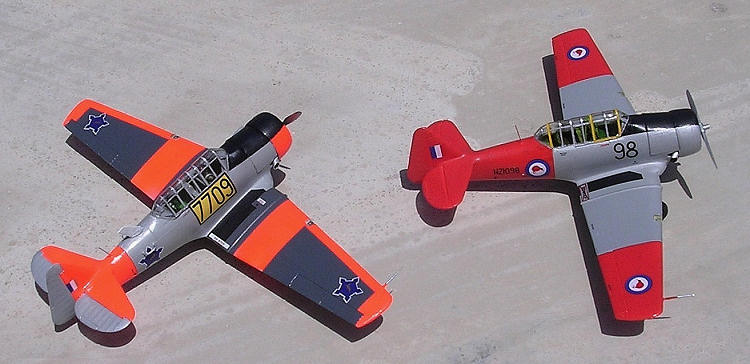
Airfix 1/72 T-6G Texan/Harvard
| KIT #: | 03066 |
| PRICE: | €7.50 |
| DECALS: | Three options |
| REVIEWER: | Carmel J. Attard |
| NOTES: | Heller Mold. Two kits are built, one in kit’s own decals, the other in Carpena RNZAF decals |

| HISTORY |
Almost certainly the most extensively used trainer of all time with more than 17,000 built by North American and others, the Harvard was derived from the N-16 prototype first flown in April 1935. A cantilever monoplane with fixed tail wheel landing gear, open cockpit in tandem and power provided by a 400hp Wright R-975 Whirlwind radial, the type after official testing received a production order under the designation BT-9.
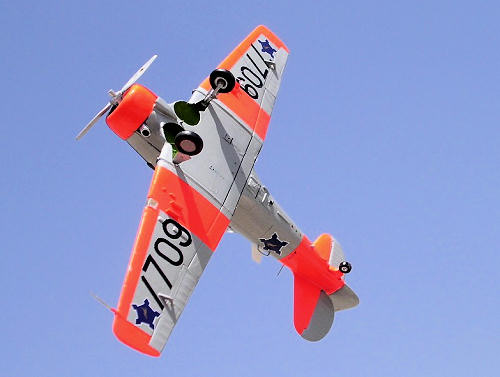 aircraft, after its wartime useful life, has been
roaring the skies in five continents with trainee airmen at the controls until
the years 1980s. The sharp rasping sound that the propeller made when a Harvard
is in the air could not be missed and is very enjoyable to the ear. The Harvard/
Texan was also used in its capacity as a light ground attack aircraft. Harvards
were used as hack aircraft at Ta’ Qali and Luqa airfields, Malta, during the war
years and after and these were camouflaged in dark earth and green.
aircraft, after its wartime useful life, has been
roaring the skies in five continents with trainee airmen at the controls until
the years 1980s. The sharp rasping sound that the propeller made when a Harvard
is in the air could not be missed and is very enjoyable to the ear. The Harvard/
Texan was also used in its capacity as a light ground attack aircraft. Harvards
were used as hack aircraft at Ta’ Qali and Luqa airfields, Malta, during the war
years and after and these were camouflaged in dark earth and green.
| THE KIT |
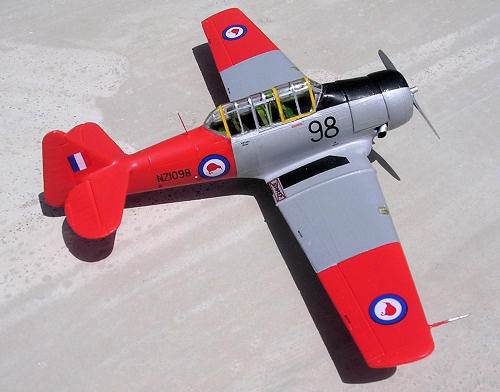 The new Airfix kit is in fact the
same old Heller one that was a better kit than the original one issued by
Airfix. This is now released in a new boxing displaying a colourful art cover of
a Texan in South African Air Force markings. Although this so to say new release
by Airfix came a couple of years ago the moulds go back to 1978. It is a very
good kit at 1/72 scale of this popular aircraft. The 42 part finely moulded kit
in yellow plastic are accurate when checked against known dimensions. The
revised 8-page A4 size instructions have easy to follow stages of construction
and also full markings for three different aircraft liveries.
One of these is a T-6G Harvard in silver and Day-Glo serving with SAAF;
another is a SK-16C Harvard of Swedish F in camouflage of olive green upper and
neutral grey lower; and a North American LT-6G Harvard in service with the
Austrian Air Force. This is a good offer for a nice selection of three liveries
from an endless variety that the T6 carried during service. Details appear to be
of high quality and yet it yearns for a detail set that we find in resin form
for the interior sidewalls in particular.
The new Airfix kit is in fact the
same old Heller one that was a better kit than the original one issued by
Airfix. This is now released in a new boxing displaying a colourful art cover of
a Texan in South African Air Force markings. Although this so to say new release
by Airfix came a couple of years ago the moulds go back to 1978. It is a very
good kit at 1/72 scale of this popular aircraft. The 42 part finely moulded kit
in yellow plastic are accurate when checked against known dimensions. The
revised 8-page A4 size instructions have easy to follow stages of construction
and also full markings for three different aircraft liveries.
One of these is a T-6G Harvard in silver and Day-Glo serving with SAAF;
another is a SK-16C Harvard of Swedish F in camouflage of olive green upper and
neutral grey lower; and a North American LT-6G Harvard in service with the
Austrian Air Force. This is a good offer for a nice selection of three liveries
from an endless variety that the T6 carried during service. Details appear to be
of high quality and yet it yearns for a detail set that we find in resin form
for the interior sidewalls in particular.
| CONSTRUCTION |
Construction starts with the sub assembly of the engine/cowling/propeller and these consist of 8 parts. The next stage is assembly of the cabin floor, seats, control stick and all items are correctly styled and even the control column has the right angle at the top. The cockpit was painted interior green; details to sidewalls added using printed side panel structure. Kit instrument panels fixed to both crew coamings. These were carefully painted in black with white dials. The bottom half of the wing is in one piece and there is a blanking plate over the wheel wells which fits very well. Be careful with the joint around the wheel wells and the wing to fuselage as the components have a thin section at the joining part and can easily snap if improperly glued and should therefore be held tight while it is fixed. Any gaps in the wheel wells that may be noticed are blended with white glue. Aileron control links are provided and appear to scale however these have to be reduced in section thickness before fitting in place. It is surprising how the extra detail to the engine
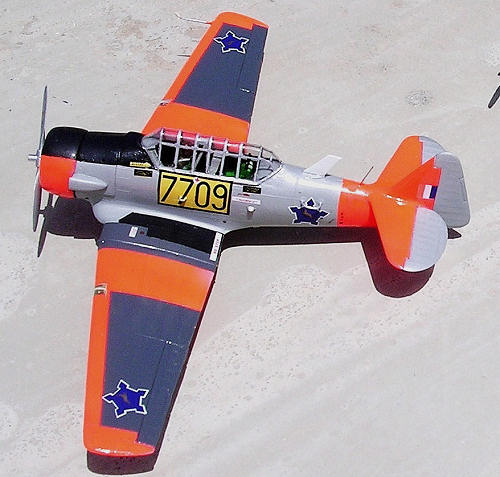 particularly at the front can make to the overall
appearance of the model. A one-piece 2-blade propeller is provided with an
optional spinner none of which is needed for any of the three versions being
offered.
particularly at the front can make to the overall
appearance of the model. A one-piece 2-blade propeller is provided with an
optional spinner none of which is needed for any of the three versions being
offered.
2. The gun pack marked impressions
under wings are removed by smoothening.
3. Stiffener strips added across
mid wings on each underside. These were made from thin plastic card cut in
rectangular shaped strips.
4. Add seat straps.
5. Add two loop shaped aerials to
rear sides of fuselage made identical from bent metal wire.
6. Drill 0.4mm diameter access
holes one to each side at aft fuselage to take lifting devices.
7. Add whip aerial and blade
antenna that do not come with the kit.
8. Thin down section of aileron
control links.
9. Add more detail under fuselage
from stretch sprue cut into bits.
10. The small intake duct (item
39) was deleted and the locating hole for it was faired over with filler.
11. Rear end of cockpit modified
and added cover at rear, made from plastic cut to shape.
12. Cockpit canopy replaced with
one from Vac-form Falcon set which is more clear and thin in section.
13. Exhaust pipe outlet opened by
drilling.
| COLORS & MARKINGS |
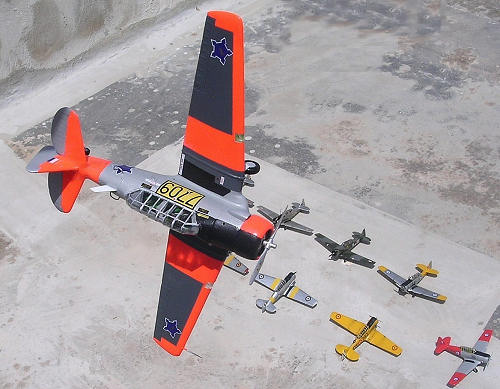 Of the three aircraft I opted to
do the Silver and day-glow and dark grey wings scheme on the SAAF Harvard, which
represents a T6G of No 40 squadron
Of the three aircraft I opted to
do the Silver and day-glow and dark grey wings scheme on the SAAF Harvard, which
represents a T6G of No 40 squadron
| CONCLUSIONS |
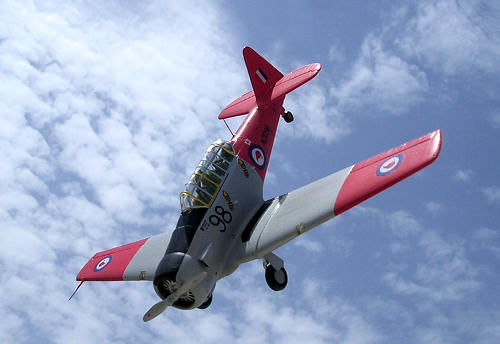 This is a very good kit to build.
With the correct reference material and small amount of additional work and
extra effort in masking it can make into a very pleasing model and this is my
suggestion to add a T6 if you do not yet have one in your collection. I made 10
so far and all in different liveries.
This is a very good kit to build.
With the correct reference material and small amount of additional work and
extra effort in masking it can make into a very pleasing model and this is my
suggestion to add a T6 if you do not yet have one in your collection. I made 10
so far and all in different liveries.
Thanks to If you would like your product reviewed fairly and quickly, please contact me or see other details in the Note to Contributors.